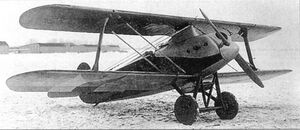Engineering:Avia BH-8
From HandWiki
Short description: Prototype Czechoslovak fighter aircraft
| BH-8 | |
|---|---|

| |
| Role | Fighter |
| Manufacturer | Avia |
| Designer | Pavel Beneš and Miroslav Hajn |
| First flight | 1923 |
| Number built | 1 |
The Avia BH-8 was a prototype fighter aircraft built in Czechoslovakia in 1923. It was an unequal-span biplane developed on the basis of the ill-fated BH-6 design, in an attempt to address that type's problems. It shared the BH-6's unusual wing cellule design.
When test-flown in late 1923, it did indeed display better flying characteristics than its predecessor, but was overtaken in development by another variation of the same design, the BH-17.
Specifications
General characteristics
- Crew: one pilot
- Length: 6.49 m (21 ft 3 in)
- Wingspan: 9.48 m (31 ft 1 in)
- Height: 2.77 m (9 ft 1 in)
- Wing area: 22.1 m2 (238 sq ft)
- Empty weight: 843 kg (1,858 lb)
- Gross weight: 1,143 kg (2,520 lb)
- Powerplant: 1 × Skoda licence-built Hispano-Suiza 8Fb Vee-8 , 310 kW (231 hp)
Performance
- Maximum speed: 222 km/h (138 mph, 120 kn)
- Range: 450 km (280 mi, 240 nmi)
- Service ceiling: 8,000 m (26,200 ft)
- Rate of climb: 5.7 m/s (1,115 ft/min)
Armament
- 2 × fixed, forward-firing .303 Vickers machine guns
See also
Related development
References
- Taylor, Michael J. H. (1989). Jane's Encyclopedia of Aviation. London: Studio Editions. pp. 86.
- World Aircraft Information Files. London: Bright Star Publishing. pp. File 889 Sheet 86.
- Němeček, V. (1968). Československá letadla. Praha: Naše Vojsko.
- airwar.ru
 |

